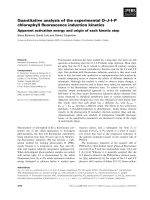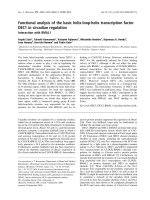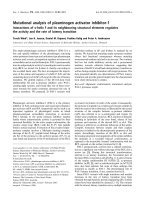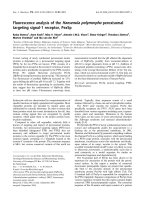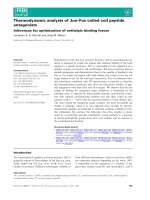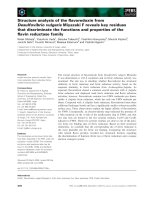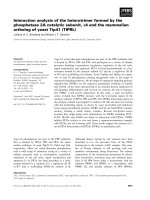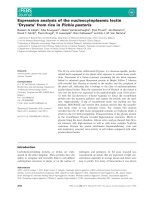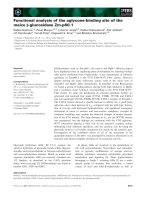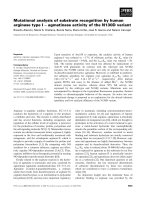Báo cáo khoa học: Mutational analysis of the C-domain in nonribosomal peptide synthesis pot
Bạn đang xem bản rút gọn của tài liệu. Xem và tải ngay bản đầy đủ của tài liệu tại đây (354.21 KB, 10 trang )
Mutational analysis of the C-domain in nonribosomal peptide
synthesis
Veit Bergendahl*, Uwe Linne and Mohamed A. Marahiel
Biochemie/Fachbereich Chemie, Philipps-Universita
È
t Marburg, Germany
The initial condensation event in the nonribosomal biosyn-
thesis of the peptide antibiotics gramicidin S and tyrocidine A
takes place between a phenylalanine activating racemase
GrsA/TycA and the ®rst proline-activating module of GrsB/
TycB. Recently we established a minimal in v itro model
system for NRPS with recombinant His
6
-tagged GrsA
(GrsA
Phe
-ATE; 127 kDa) and T ycB1 (TycB1
Pro
-CAT;
120 kDa) and demonstrated the catalytic function of the
C-domaininTycB1
Pro
-CAT to form a peptide bond
between phenylalanine and proline during diketopiperazine
formation (DKP). In this work we took advantage of this
system to identify catalytically important residues in the
C-domain of TycB1
Pro
-CAT using site-directed mutagenesis
and peptid e mapping. Mutations in TycB1
Pro
-CAT of 10
strictly conserved residues among 80 other C-domains with
potential catalytic function, revealed that only R62A,
H147R and D151N are impaired in peptide-bond
formation. All o ther mutations led to either unaected
(Q19A, C154A/S, Y166F/W and R284A) or insoluble
proteins (H146A, R67A and W202L). Although 100 n
M
of
theserineproteaseinhibitorsN-a-tosyl-
L
-phenylalanylchlo-
romethane or phenylmethanesulfonyl ¯uoride completely
abolished DKP synthesis, no covalently bound inhibitor
derivatives in the C-domain could be identi®ed by peptide
mapping using HPLC-MS. Though the results do not reveal
a particular mechanism for the C-domain, they exhibit a
possible way of catalysis analogous to the functionally
related enzymes chloramph enicol acetyltransferase and
dihydrolipoyl transacetylase. Based on this, we propose a
mechanism in which one catalytic residue (H147) and two
other structural residues (R62 and D151) are involved in
amino-acid condensation.
Keywords: nonribosomal peptide synthesis; nonribosomal
peptide synthetases; peptide synthetases; condensation
domain; chloramphenicolacetyltransferase.
A broad range of organisms utilize nonribosomal peptide
synthesis to produce an immense spectrum of bioactive
peptides (antibiotics, siderophores, biosurfactants and
immunosuppressants, as well as antitumor and antiviral
agents). For that purpose, they avail themselves a large
number of amino and carboxy acids as substrates. The
biosynthesis of these pharmacological signi®cant agents is
performed by nonribosomal peptide synthetases (NRPS),
which in their modular organ ization are related to poly-
ketide synthases ( PKS) [1,2]. These large multifunctional
enzymes are arranged in assembly lines with specialized
units completely equipped for the correct activation and
incorporation of a single substrate. Such catalytic units,
referred to as m odules, are composed of functionally speci®c
and independent domains, each of them responsible for
catalyzing one single reaction. Remarkably, the order of the
modules (with a repetitious assembly of domains) is
predominantly colinear to the ®nal product [3,4].
The C-domain, a 450-amino-acid expanding region at the
N-terminus of each elongating module, was attributed after
extensive sequence analysis with the condensation activity.
It was previously con®rmed to be responsible for the
catalysis of peptide bond f ormation by the development of a
minimized system representative for this family of enzymes
[5]. Furthermore r ecent ®ndings indicate that the C-domains
are bearing signi®cant substrate selectivity for the nucleo-
philic accepto r amino acid and a n enatiosele ctivity for the
electrophilic donor substrate [6]. The inherent selectivity at
the accep tor site has been shown t o p revent internal
misinitiation of the biosynthetic process and to control the
timing of substrate epimerization [7]. Recognition and
activation of the substrate amino acid are facilitated by the
A-domain [8] through carboxy adenylation of the substrate.
Hence, the substrate selectivity of the A-domains [9]
simultaneously determines the primary sequence of the
product. Subsequently the a ctivated amino acid i s tethered
to the terminal thiol moiety of a 4¢-phosphopantetheinyl
(Ppant) group [10,11]. This Ppant-cofactor itself is post-
translationally transferred to a conserved serine residue of
the T-domain a lso designated a s PCP (peptidyl c arrier
protein) by a special class of CoASH binding 4¢-Ppant-
transferases [12±14]. Besides these three domains (C-A-T),
which are essential for a functional elongating m odule, there
are some optional domains for further modi®cation of t he
Correspondence to M. A. Marahiel, Biochemie/Fachbereich Chemie,
Philipps-Universita
È
t Marburg, H ans-Meerwein-Straûe, 35032 Mar-
burg, Germany. Fax: + 49 6421 2822191, Tel.: + 49 6421 2825722,
E-mail:
Abbreviations: A-domain, adenylation domain; C-domain, condensa-
tion domain, DKP,
D
-Phe-
L
-Pro-diketopiperazine; E-domain, epi-
merization domain; IPTG, isopropyl thio-b-
D
-galactoside; LSC, liquid
scintillation counting; NRPS, nonribosomal p eptide synthetases;
PKS, polyketide synthases; Ppant, 4¢-phosphopantetheine; PP
i
,inor-
ganic pyrophosphate; T-domain, thiolation domain (also described as
PCP, peptidyl-carrier-protein).
*Present address: McArdle Laboratory for Cancer Research, Univer-
sity of Wisconsin, Medical School, 1400 University Avenue, Madison,
WI 53706, USA.
(Received 16 August 2001, revised 15 November 2001, accepted 20
November 2001)
Eur. J. Biochem. 269, 620±629 (2002) Ó FEBS 2002
substrate amino acids. Those domains are the epimerization
domain (E-domain) for C
a
-epimerization [15], the methyl-
transferase domain (M-domain) for N-methylation [16] and
the cyclization domain (Cy-domain) [17]. These latter
domains are related to the C-domains, as they catalyze the
simultaneous condensation and heterocyclization of two
aminoacyl or p eptidyl s ubstrates. Release of the ®nal
product is catalyzed by a thioesterase (Te)-like domain
found at the C-terminal t erminating module of NRPSs
templates [18,19].
The enormous size and complexity of most peptide
synthetases (up to 1.6 MDa [20]) have signi®cantly
restrained a more detailed study of the C-domain f unction
in the past. Therefore, we previously established a mini-
mized NRPS in vitro system [5], which comprises of the
initiation module GrsA
Phe
-ATE (phenylalanine-activating
module; A-, T- and E-domain) from the gramicidin S
system and the ®rst module i n the second peptide synthetase
of the tyrocidine A system TycB1
Pro
-CAT (proline-activat-
ing module; C-, A-, and T-domain; see Fig. 1). Both
proteins can be obtained in active form as recombinant
His
6
-tag fusions by overexpression in E. coli [5]. By applying
previously described in vitro assays, it is now possible to
monitor the condensation of their cognate substrates
L
-Phe
and
L
-Pro, and the presumably uncatalyzed intramolecular
cyclization that ends up in the release of the cyclic dipeptide
D
-Phe-
L
-Pro-diketopiperazine (DKP; see Fig. 2). The same
system was also utilized to demonstrate that C-domains
possess an in trinsic editing function for the incoming
aminoacyl moiety [6]. By using aminoacyl-S-CoA as probes
it was shown that the ®rst C-domain of the tyrocidine
synthetase complex possesses an enantioselectivity a t the
electrophilic donor s ite (
D
-Phe) and a s ubstrate speci®city at
the nucleophilic acceptor site (
L
-Pro) in the formation o f t he
chain-initiating
D
-Phe-
L
-Pro dipeptidyl intermediate. The
knowledge about the architecture that creates this selectivity
and the residues, which are involved in catalysis of peptide-
bond formation remained largely unclear.
Sequence analysis revealed a highly conserved motif
HHxxxDGx(S /C), commonly called ÔHis-motifÕ,thatwas
suspected to participate in the catalysis. This hypothesis was
supported by the ®nding that a single mutation of the
Fig. 1. Genes and domain organizations of
gramicidin S and tyrocidine A synthetases.
These genes lead to the minimal syste m com-
prising the NRP Ss G rsA
Phe
-ATE (from grsA)
and TycB1
Pro
-CAT (from tycA). Domains are
depicted to illustrate the module structure. The
amino-acid selectivity of each A-domain is
indicated using the three-letter code. TycA and
GrsA are highly s imilar to each other and can
be used interchangeably, just as GrsB1 and
TycB1.
Fig. 2. Currently accepted model of the con-
densation of
L
-Phe and
L
-Pro as catalyzed by
the peptide synthetases GrsA
Phe
-ATE and
TycB1
Pro
-CAT. The crucial known step s of
peptide bond formation in NRPSs are illus-
trated for the current system using the texture
code of Fig. 1. First the substrate amino acids
are activated under ATP hydrolysis as
an adenylate and then enzyme bound on the
PpantmoietyofeachT-domainasa
thioester.
L
-Phe-S-Ppa nt is then epimerized by
the E-domain of GrsA
Phe
-ATE, but
only
D
-Phe-S-Ppant undergoes condensation
with
L
-Pro-S-Ppant presented at the C-do-
main of TycB1
Pro
-CAT. Free GrsA
Phe
-ATE
can now be reloaded w hereas
D
-Phe-
L
-Pro-
DKP can be released by intramolecular cycli-
zation on TycB1
Pro
-CAT.
Ó FEBS 2002 Catalysis of nonribosomal peptide-bond formation (Eur. J. Biochem. 269) 621
second histidine residue (italic) in TycB1
Pro
-CAT (H147V)
was suf®cient to abolish peptide bond and DKP formation
with GrsA
Phe
-ATE [5]. Furthermore, a chromosomal point
mutatio n in srfA-B, changing a D to A in the His-motif
(italic) of the corresponding Asp domain of the surfactin
synthetase was found to abolish surfactin production in
the B. subtilis producer strain [21]. Accordingly, the pres-
ence of a catalytic diad or triad [22] was discussed on the
basis of sequence analysis and in a proposed analogy to the
family of dihydrolipoyl transacetylases or chloramphenicol
acetyltransferases [23,24]. Among the questions about
C-domain function are (a) what (additional) residues are
important for catalysis of peptide-bond formation, (b) how
are these residues arranged in the catalytic center, and (c)
whether the growing aminoacyl (or peptidyl) donor is
getting (at least at same point) covalently tethered to the
C-domain? To address these questions, mutants in residues
conserved across 80 NRPS C-domains were constructed in
the C-domain of TycB1
Pro
-CAT and assayed for their
ability to catalyze peptide bond formation between
D
-Phe-
S-Ppant-GrsA
Phe
-ATE and
L
-Pro-S-Ppant-TycB1
Pro
-
CAT. Furthermore, the minimal system GrsA
Phe
-ATE/
TycB1
Pro
-CAT was compromised with two inhibitors
(phenylmethanesulfonyl ¯uoride and N-a-tosyl-
L
-phenyl-
alanylchloromethane), and analyzed for the appearance
of possible covalent C-domain/inhibitor complexes in order
to ®nd a catalytic triade similar t o the one in serine
proteases.
EXPERIMENTAL PROCEDURES
Sequence alignments for the identi®cation of highly
conserved residues
The sequences of more than 80 C-domains we re retrieved
from publicly accessable databases (NCBI, SwissProt, etc.).
Sequences used were derived from biosynthesis systems of
gramicidin S (Grs), tyrocidin A (Tyc), s urfactin (Srf),
lichenysin (Lic), bacitracin ( Bac), fengycin (Fen), ente ro-
bactin (Ent), chloroeremomycin (Cep), pristinamycin (Snb),
enniatin (Esyn), HC-toxin (Hts1), penicillin (Acv) and
cyclosporin (SimA). After outlining the 450-amino-acid
stretches, the sequences were aligned using the program
MEGALIGN
from the DNA Star package, applying the Jotun
Hein algorithm with default parameters.
Site-directed mutagenesis and cloning
All TycB1
Pro
-CAT mutants were constructed by site-
directed mutagenesis of pProCAT [5] using either the so-
called ÔMegaprimer-PCRÕ method [25] with the Expand
long-range PCR system
TM
(Bo
È
hringer Mannheim, Germa-
ny) or t he QuickChange
TM
Site-Directed Mutagenesis K it
(Stratagene). Restriction sites f or subsequent cloning and
screening were i ntroduced with PCR oligonucleotides
(MWG-Biotech, Germany) summarized in Table 1. Quick-
Change
TM
mutagenesis was carried out in accordance with
the m anufacturer's protocol. For the ÔMegaprimer-PCRÕ,
PCR products were puri®ed with the QIAquick-spin PCR
puri®cation kit (Qiagen, Germany), digested with NcoIand
ligated. Standard procedures were applied for all DNA
manipulations [26] and the Escherichia coli strain XL1-Blue
[27] was used for cloning. The mutant TycB1
Pro
-
CAT(H147V) was obtained by site-directed mutagenesis
as described pre viously [5]. Together with the desired point
mutations, additional silent mutations were introduced in
order to g enerate a new restriction site, which allowed a
simple detection of all mutated plasmids. The fusion sites
between vector and insert, as well as th e mutation-site of the
plasmids pProCAT were con®rmed by DNA sequencing
using an ABI-Prism 310 Genetic Analyzer with standard
protocols described by ABI (Applied Biosystems,
Germany).
Expression and puri®cation of functional holo-peptide
synthetase fragments
To achieve in vivo production of functional holo-peptide
synthetase modules, the Ppant-transferase gene gsp was
coexpressed with the pQE60 plasmids carrying the DNA
fragments for the TycB1
Pro
-CAT mutants. Expression and
puri®cation using single-step Ni
2+
-af®nity chromatography
was performed according to previously published proce-
dures [5]. Purity of the proteins was judged by SDS/PAGE
(data not shown). Fractions containing the recombinant
proteins were pooled and dialyzed against assay buffer
(50 m
M
Hepes, pH 8.0, 100 m
M
sodium chloride, 10 m
M
magnesium c hloride, 2 m
M
dithioerythritol and 1 m
M
EDTA). After addition of 10% glycerol (v/v), the proteins
could be stored at )80 °C. Protein concentrations were
determined using the calculated extinction coef®cients for
the A
280
of the proteins: 138 690
M
)1
ácm
)1
for GrsA
Phe
-
ATE and 92 230
M
)1
ácm
)1
for TycB1
Pro
-CAT and its
mutants .
ATP-pyrophosphate exchange assay
The ATP-pyrophosphate exchange reaction was carried out
to examine the adenylation activity of all recombinant
peptide synthetase fragments puri®ed. Reaction mixtures
contained (®nal volume: 100 lL): 50 m
M
Hepes, pH 8.0,
100 m
M
sodium chloride, 10 m
M
magnesium chloride,
1m
M
EDTA, 1 m
M
amino acid and 300 n
M
enzyme. The
reaction was i nitiated by the addition of 2 m
M
ATP, 0.2 m
M
tetrasodium pyrophosphate and 0.15 lCi of tetrasodium
[
32
P]pyrophosphate (NEN/DuPont) a nd incubated at 37 °C
for 10 min. Reactions were quenched by adding 0.5 m L of a
stop mix c ontaining 1.2% (w/v) activated charcoal, 100 m
M
tetrasodium pyrophosphate and 3 50 m
M
perchloric acid.
Subsequently, the charcoal was pelleted by centrifugation,
washed once with 1 mL water and resuspended in 0.5 mL
water. After addition of 3.5 mL of liquid scintillation ¯uid
(Rotiscint Eco Plus; Roth, Germany), the charcoal-bound
radioactivity was determined by liquid scintillation c ounting
(LSC) with a 1900CA Tri-Carb liquid scintilliaton analyzer
(Packard).
Thioester formation: radioassay for the detection
of covalent amino-acid incorporation
Reaction mixtures in assay buffer (50 m
M
Hepes, pH 8.0,
100 m
M
sodium chloride, 10 m
M
magnesium chloride,
1m
M
EDTA) contained 500 n
M
enzyme, 2 m
M
ATP and
2 l
M
[
14
C]-amino acid (Hartmann, Germany). The thio-
esteri®cation was initiated upon the addition of the radio-
labeled amino acid and the reaction was quenched after
622 V. Bergendahl et al. (Eur. J. Biochem. 269) Ó FEBS 2002
10 min by the addition of 1 mL chilled 10% (w/v)
trichloroacetic acid and incubated on ice for 15 min. The
precipitates were pelleted by centrifugation (4 °C, 16 000 g)
and washed two times with 1 mL 10% trichloroacetic acid
(w/v). The pellet containing the acid-stable label was then
dissolved in 150 lL formic acid and quanti®ed by LSC as
described above.
Method of normalization for values in condensation
assays
A common margin of error is made when determining a
protein concentration b y the calculated extinction coef®-
cient. According to our experience, the current set o f
proteins has s hown that thioesteri®cation activities may
vary signi®cantly (up to threefold) depending on the b atch
of protein utilized in the assays. I n the present work, we tried
to tak e this behaviour into consideration by normalizing the
values with the thiolation activ ity as an internal standard for
amount of active protein. We normalized the values
obtained in all the assays for dipeptide formation a nd for
DKP production by multiplying the counts in the radioac-
tive assays and the area in the HPLC-assays by the ratio of
counts in the thiolation assay of mutant over wild-type.
Values in the elongation a ssay were expressed as relative
values to the value at t 0 which was set as 100%. DKP
amounts were also expressed a s relative values (percent of
wild-type value).
Radio assay for the detection of elongation
500 n
M
of holo-enzyme (GrsA
Phe
-ATE and TycB1
Pro
-
CAT) were preincubated seperately in assay buffer with
their substrate amino acids [2 l
M
[
14
C]
L
-Phe (450 mCiám-
mol
)1
), 100 l
ML
-Pro] and ATP ( 2 m
M
). After 3 min,
product formation was initiated by mixing equal volumes
of reaction mixtures. At various time-points, 200 lL
aliquots were taken and immediately quenched by addition
of 1 mL ice-cold trichloroacetic acid (10%). After 15 min
on ice, samples were centrifuged (4 °C, 16 000 g)for
20 min, w ashed two times with 1 mL ice-cold trichloro-
acetic acid, redissolved in 150 lL formic acid and quan-
ti®ed by LSC.
DKP formation: indirect assay for
D
-Phe-
L
-Pro dipeptide
formation
The formation of the dipeptide was analyzed using G rsA
Phe
-
ATE and the different C-domain mutants of TycB1
Pro
-
CAT. To ensure a complete acylation of the p eptide
synthetase fragments with their cognate amino acids, a
preincubation was carried out for 3 min at 37 °C; 1 l
M
GrsA
Phe
-ATE was incubated in assay b uffer containing
2m
M
ATP and 0.5
M
phenylalanine (mixture A), and
TycB1
Pro
-CAT mutants were incubated in assay buffer
containing 1 l
M
enzyme, 2 m
M
ATP a nd 0.5 m
M
proline
(mixture B). For reactions with N-a-tosyl-
L
-phenylalanyl-
chloromethane and phenylmethanesulfonyl ¯uoride the
inhibitor was suspended in ethanol and added to mixture B
without exceeding 1% ethanol content in the reaction
mixture. The condensation reaction was initiated by the
addition of 1 vol. of mixture B to 1 vol. of mixture A and
incubated 45 min at 37 °C. In order to analyze the nature of
the product(s), the reaction mixture (1 mL) was diluted by
adding 4 mL water and immediately extracted with buta-
nol/chloroform [4 : 1; (v/v)]. The organic phases w ere
Table 1. Primers used for mutagenesis destinguished by the two dierent PCR techniques applied. The restriction sites indicated were introd uced to
ease the screening for mutated plasmids after cloning. OP refers to outer primer and MP to megaprim er. Also the desired mutation is ind icated in
the name of each primer. (lower case: modi®ed se quences; bold: re striction sites).
Name of primer Sequence
Restriction
enzyme
Megaprimer PCR OP1 5¢-cat gCC ATG GGT GTA TTT AGC-3¢ NcoI
OP2 5¢-cat gCC ATG GTT AAT TTC TCC TCT TTA ATG-3¢ NcoI
MP(D151N) 5¢-GAA GCA CCA GCC GTt CAT GAG GAT GTG-3¢ BspHI
MP(C154S) 5¢-AAT GCT GAA GgA CCA GCC GTC CAT GAG-3¢ AvaII
MP(C154A) 5¢-AAT GCT GAA tgc CCA GCC GTC CAT GAG-3¢ BsmI
MP(H146A) 5¢-CCA TGA GGA TGT Gcg cAA AGC TCC A-3¢ FspI
MP(H147R) 5¢-CCA TGA GGA Tcc GAT GAA AGC TCC A-3¢ BamHI
MP(Y166W) 5¢-GCA AGG ACA Acc AtA TGG CAA GCA AGT C-3¢ NdeI
MP(Y166F) 5¢-GCA AGG ACA Aga AgA TGG CAA GCA AGT C-3¢
QuickChange
TM
3¢Q19A 5¢-GCG TTG ACC CCG ATG gcc GAG GGG ATG CTG TTT CAC-3¢ CfrI
5¢Q19A 5¢-GTG AAA CAG CAT CCC CTC ggc CAT CGG GGT CAA CGC-3¢ CfrI
5¢R62A 5¢-CTG CAT GTG CTG GTA GAG gcc TAC GAT GTA TTC CGC ACG-3¢ AatI
3¢R62A 5¢-CGT GCG GAA TAC ATC GTA ggc CTC TAC CAG CAC ATG CAG-3¢ AatI
5¢R67A 5¢-GGT AGA GAG ATA CGA TGT ATT Cgc gAC GTT GTT TAT CTA TGA
AAA GC-3¢
NruI
3¢R67A 5¢-GCT TTT CAT AGA GAA ACA ACG Tcg cGA ATA CAT CGT ATC TCT
CTA CC-3¢
NruI
5¢W202L 5¢-CAG GCC GCT CTC AAC TAc Tta AGC GAC TAT CTG GAA GCC-3¢ A¯II
3¢W202L 5¢-GGC TTC CAG ATA GTC GCT taA gTA GTT GAG AGC GGC CTG-3¢ A¯II
5¢R284A 5¢-GGC TCT GTT GTA TCC GGA gct CCT ACA GAC ATC GTC GG-3¢ SacI
3¢R284A 5¢-CCG ACG ATG TCT GTA GGa gcT CCG GAT ACA ACA GAG CC-3¢ SacI
Ó FEBS 2002 Catalysis of nonribosomal peptide-bond formation (Eur. J. Biochem. 269) 623
transferred to fresh tubes and washed once with 5 mL of
0.1
M
sodium chloride. A fter removal of the solvent under
vacuum, the reminders of each reaction were further
investigated by HPLC or HPLC-MS. The samples prepared
were resolved in 200 lL 10% of buffer B and the products
separated by using a C18 reversed-phase column (Nucleosil
3mm´ 250 mm, pore-size 120 A
Ê
, particle-size 3 lm;
Macherey & N agel) o n a HP1100 HPLC-MS system
(Agilent Technologies) with simultaneous monitoring at
detector wavelengths of 214 and 256 nm. The following
gradient pro®le was used at a ¯ow-rate of 0.35 mLámin
)1
:
loading (10% buffer B), linear gradient to 30% buffer B in
1 m in, followed by a linear gradient to 100% buffer B in
20 min, and then holding 100% buffer B for 10 min
(buffer A, 0.05% formic acid in H
2
O; buffer B, 0.04%
formic acid in methanol).
Peptide mapping of trypsin-digested TcyB1
Pro
-CAT
Peptide mapping of TycB1
Pro
-CAT was performed accord-
ing to the manufacturer's p rotocol using the Sequencing
Grade Modi®ed T rypsin Kit (Promega). Treatment of
protein with N-a-tosyl-
L
-phenylalanylchloromethane or
phenylmethanesulfonyl ¯uoride was performed before the
digest by incubating a 10-fold excess of inhibitor with
TycB1
Pro
-CAT (1 l
M
)for10minat25°C. N-a-Tosyl-
L
-phenylalanylchloromethane and phenylmethanesulfonyl
¯uoride treated protein (1 mg) was precipitated and washed
once with aceto ne to eliminate residual inhibitor that might
interfere with the digest [28]. HPLC conditions were as
described by Promega except for using a HP1100 HPLC-MS
system and a C18 reversed-phase column (Nucleosil
3 ´ 250 mm, pore size 120 A
Ê
,particlesize3lm; Macherey
& Nagel).
RESULTS
Homology searches to select targets for the site-directed
mutagenesis of the C-domain in TycB1
Pro
-CAT
For a fairly long time, virtually no biochemical d ata were
available on C domains, and consequently, this 450-
amino-acid stretch was considered to be only a spacer
between consecutive, amino-acid-activating A-T bi-domains
[29]. Recently, howe ver, it could be demonstrated that this
region is actually responsible for catalysis of peptide bond-
formation [5]. Furthermore, it was noted that C-domains
share the signature sequence motif HHxxxDGxSW (the
so-called ÔHis m otifÕ) with a superfamily of acyl transferases,
and that the second His and the Asp residues are
indispensable for C-domain activity [ 5,21]. To identify
additional catalytic key residues, we started our study with
alignments of the primary sequences of NRPSs C-domains.
A scan of 80 C-domains revealed an overall similarity
ranking from 60% (between TycB1 and GrsB1) to < 20%
(between TycB1 and Hts1), with an average percentage of
similarity of 35% (data not shown). Among all C-domains
investigated, we f ound eight absolutely i nvariant residues, o f
which all have functionalized side chains (carboxyl, amino,
amine, guanidino, sulfhydryl or hydroxyl groups). These
latter residues (namely Q19, R62, R67, H146, H147, D151,
W202 and R284 within TycB1
Pro
-CAT) and additionally
C154 and Y166 ( > 95% cons erved and discussed as
potentially involved in catalysis) were selected as targets
for the subsequent mutational analysis.
Generation and puri®cation of the recombinant
enzymes
In this study, we constructed a set of 12 TycB1
Pro
-CAT [5]
single mutants (Q19A, R62A, R67A, H 146A, H147R,
D151N, C154S, C154A, Y166W, Y151F, W202L and
R284A). Mutations other than to alanine were intentionally
designed to show residual activity for similar functional
groups (H/R, D/N, C /S and Y/W) as opposed to residues
with no functionalized group (H/V, C/A and Y/F). In case
of a catalytic triade Asp-His-Ser or Asp-His-Tyr similar
functionalized groups were expected to exhibit residual
activity, whereas unfunctionalized groups would have none.
All m utants were individually expressed as C -terminal His6-
tag fusions in the heterologous host E. coli and puri®ed by
Ni
2+
-af®nity chromatography. As judged by SDS, a ll
proteins could be puri®ed to homogeneity (data not shown),
although in gene ral, the solu bility of the re combinant
proteins appeared not to be very high (as estimated on
< 30% by comparison after SDS/PAGE of pellet and
supernatant after cell lysis). Highest amounts of soluble
protein comparable to wild-type level were obtained for
mutants Q19A, R62A, H147V, H147R, C154S and
C154A. Preparation of mutants D151N, Y166W, Y151F,
R284A revealed slightly lower solubilities. Mutants R67A,
H146A and W202L gave less than 0.5 mg soluble protein
per L culture indicating a misfolding induced by the
mutation. In order to test for correct folding, all mutants
were subjected to ATP±PP
i
exchange assay, which a ssesses
the a ctivity and selectivity of the A domain embedded
within the C- and T-domains of all t ridomain TycB1
Pro
-
CAT derivatives. Although A domain activity indicates a
correct folding of the entire TycB1
Pro
-CAT enzymes, it
cannot be excluded that the connected C- and T-domains
domains are somehow impaired in folding. The assay
revealed that within an error-margin of < 5%, the same
wild-type amino-acid dependent activity in the ATP±PP
i
-
exchange assay could be obtained for most mutants,
indicating that their structure cannot have changed much
if at all. Three TycB1
Pro
-CAT mutants, R67A, H146A and
W202l sustained a drop in adenylation activity to less than
5% wild-type activity and therefore are likely t o be affected
in folding (see below).
Dipeptidyl-
S
-Ppant- and DKP-formation
Prior studies revealed that C-domains are the peptide bond-
forming catalysts, which raises the question of how
ef®ciently the C-domain mutants of TycB1
Pro
-CAT t ransfer
the
D
-Phe moiety from GrsA
Phe
-ATE. To assay for the
formation of the dipeptidyl-S-Ppant nascent product,
L
-Pro
was allowed to load onto holo-TycB1
Pro
-CAT mutants in
the p resence of ATP. Sub sequently, t he
L
-Pro-S-Ppant-
enzymes were mixed, respectively, with holo-GrsA
Phe
-ATE,
which had been loaded in a preincubation with ATP and
radiolabeled
L
-[
14
C]Phe. Once translocation of
D
-[
14
C]Phe
from GrsA
Phe
-ATE to TycB1
Pro
-CAT occurs by C-domain
catalysis, the vacant holo-GrsA
Phe
-ATE is rapidly reloaded
with surplus
L
-[
14
C]Phe. Thus, if samples are taken at
de®ned time points and immediately quenched b y the
624 V. Bergendahl et al. (Eur. J. Biochem. 269) Ó FEBS 2002
addition of 10% (w/v) trichloroacetic acid, the measurable
amount of acid-stable label should increase f rom one
equivalent to two equivalents, as at that poin t GrsA
Phe
-ATE
and TycB1
Pro
-CAT are both radiolabeled. Simultaneously,
the
D
-[
14
C]Phe-
L
-Pro dipeptide is slowly autoreleased from
TycB1
Pro
-CAT by cyclization to DKP. Consequently, as
soon as all
L
-[
14
C]Phe has been consumed, the amount of
acid-stable label will decrease again until all enzyme has
been liberated of radiolabeled substrate.
This assay for dipeptide and DKP formation was
performed w ith wild-type GrsA
Phe
-ATE an d all TycB1
Pro
-
CAT C-domain mutants except mutants R67A, H146A and
W202L. The latter ones were not tested further, as they
proved to be insoluble o r misfolded. As positive a nd
negative controls we performed the assay with wild-type
TycB1
Pro
-CAT instead of mutants and without TycB1
Pro
-
CAT [5]. On the basis o f the results obtained by LSC
(summarized in Fig. 3), the TycB1
Pro
-CAT mutants can be
categorized in three groups. Three mutants (Q19A, Y166W
and R284A) revealed no effect on dipeptide-formation and
release of DKP (Fig. 3A). A second group (C154A, C 154S,
Y166F) was asymmetrically impaired in DKP release,
implying that the release of
D
-Phe-
L
-Pro-DKP is somehow
in¯uenced by the functional side-chain moieties of C154
and Y166 (Fig. 3B). The most interesting group, how-
ever, consists of four TycB1
Pro
-CAT C-domain mutants
(R62A, H147R, H147V and D151N) that are completely
impaired in dipeptide formation (Fig. 3C). This i ndicates
that the three residues affected are essential for the
translocation of
D
-Phe-S-Ppant from GrsA
Phe
-ATE to
TycB1
Pro
-CAT.
The product of the condensation assay, DKP, is readily
extractable into organic solvent [5]. Thus, for a more
detailed analysis of the product(s) formed, the assays were
performed with nonradiolabeled substrates. After 45 min,
reactions were extracted with butanol/chloroform and
analyzed by HPLC-MS. The results of the HPLC-MS
analysis, which are summarized in Fig. 4, revealed that
D
-Phe-
L
-Pro-DKP was synthesized as the only product in
the case of the mutants Q19A, C154A/S, Y166W/F and
R284A. The amount of DKP produced ranged from 30 to
100% of the wild-type TycB1
Pro
-CAT (normalized for
thiolation activity). Changes in turnover are evident for
C154S and R284A, but most signi®cantly for Y166F and
Y166W, by a decreased a mount of DKP synthesized. In
contrast, no DKP at all could be detected when using R62A,
H147V/R or D151A.
Peptide mapping of
N
-a-tosyl-
L
-phenylalanylchloro-
methane and phenylmethanesulfonyl ¯uoride
treated TycB1
Pro
-CAT
Possible catalytic mechanisms for the formation of pep-
tide bonds would be for example a catalytic triade as
in serine proteases or catalytic diade as found in
Fig. 3. Time dependence of dipeptide and DKP formation between
GrsA
Phe
-ATE and C-do main mutants of T ycB1
Pro
-CAT. Normalized
counts are plotted against the time of sampling. The increase in acid-
stable label accounts to the translocation of labeled Phe onto
TycB1
Pro
-CAT and rapid reloading of GrsA
Phe
-ATE. Both labeled
proteins can be precipitated by 10% trichloroacetic acid solution.
Mutants Q19A, Y166W and R284A revealed no eect on dipeptide-
formation and release of DKP represente d by the plot of Q19A. The
second group (C154A, C154S, Y166F), represented by the plot of
Y166F, is only impaired in DKP f ormation, implied by the slow
decresae of the acid stable label. The most in teresting g roup, however,
is represented by the plot of R62A. It consists of four TycB1
Pro
-CAT
C-domain mutants (R62A, H147R, H147V and D151N) that are
signi®cantly impaired in dipeptide formation, as there is no increase in
acid stable label which could indicate a formation of a Phe-Pro
dipeptide.
Ó FEBS 2002 Catalysis of nonribosomal peptide-bond formation (Eur. J. Biochem. 269) 625
chloramphenicolacetyltransferases [23,24]. Most strikingly,
all results obtained so far were in f avor of the latter mode of
action, and we a lso were not able to detect a conserved
serine residue that might act in the catalytic center of
C-domains. To further rule out the possibility of a catalytic
triade, we n ext investigated the inhibition of dipeptide and
DKP formation in the presence of N-a-tosyl-
L
-phenylalanyl-
chloromethane and phenylmethanesulfonyl ¯uoride. Both
inhibitors form covalent complexes with their target
enzymes via catalytically exposed serine and histidine
residues, respectively. We found that the minimal system
was susceptible to complete inhibition of DKP synthesis by
100 n
M
N-a-t osyl-
L
-phenylalanylchloromethane and phen -
ylmethanesulfonyl ¯uoride (data not shown). Consequently,
we next performed a partial digest with trypsin of TycB1
Pro
-
CAT, which had been pretreated with inhibitor. Tryptic
digests were applied to HPLC and analyzed by a coupled
MS. Focusing only on tryptic fragments derived from the
C-domain, we were able to separate the resulting peptides by
reversed-phase chromatography and to trace out theoretical
fragments larger than 500 m/z by MS (calculated by peptide
tools, Agilent Technologies; data not shown). However,
none of them showed an increase in mass that would occur
by covalent derivatization with N-a-tosyl-
L
-phenylalanyl-
chloromethane or phenylmethanesulfonyl ¯uoride one
would expect in the case of a catalytic triade. No further
efforts were made to track down the actual target of the
inhibitors.
DISCUSSION
The purpose of t his work was to identify the key residues
in the C-domain a nd their potential role in the catalytic
mechanism. For t his purpose, sequence alignments of 80
C-domains were made and lead to 10 invariant residues
(100% identity except C154 and Y166, who showed
100% similarity by variation with serine in four cases
and phenylalanine in one case). These residues were Q19,
R62, R67, H146, H147, D151, C154, Y166, W202 and
R284.
Figure 5 summarizes the results of the site-directed
mutagenesis. Mutations of residues R67, H146 and W202
seemed to be structurally important as judged by their lack
of solubility. Residues Q19, C154, Y166 and R284 were
found to be not essential to the condensation activity. The
condensation reaction requires the action of various
domains, so we a re dealing w ith sets o f coupled catalyzed
and noncatalyzed reactions (adenylation, thiolation, epi-
merization and noncatalyzed cyclization) resulting in c om-
plex kinetic i n¯uences. Consequently, a more thorough
analysis of the mutants does not seem to be possible with the
current methods. In contrast, mutation of residues R 62,
Fig. 5. Summary of all observed eects for
every TycB1
Pro
-CAT mutant examin ed. The
diagram shows a schematic presentation of the
450-amino-acid C-domain of TycB1
Pro
-CAT,
along with the approximate locatio n of core-
motifs C1±7 [3]. Underneath, the eects of
each mutation on solubility and various
activities of each domain are rated by Ô+Õ
(soluble or active) and Ô±Õ (insoluble or in-
active). A gray background emphasizes the
mutants R62A, H147V/R and D151N in
particular, as they showed only a loss in con-
densation activity, while the other domains
appear to be uneected.
Fig. 4. Relative amount of DKP generated with GrsA
Phe
-ATE and
C-domain mutants of TycB1
Pro
-CAT. The quantity of D KP synthe-
sized (determined by HPLC-MS) using wild-type TycB1
Pro
-CAT was
set 100% and errors were calculated from a series of three consecutive
experiments with the same batch of protein.
626 V. Bergendahl et al. (Eur. J. Biochem. 269) Ó FEBS 2002
H147 and D151 were found to abolish C-domain activity
completely, while being still active in adenylation a nd
thiolation activities. In p revious work, His147 was already
found to be essential for condensation [5] and the
corresponding residue of D151 in the SrfB2
Asp
-CAT
surfactin synthetase essential for the synthesis of surfactin
in B. subtilis, shown in vivo [21,30]. In the present study we
additionally found R62 to be essential for condensation
activity. D151 was veri®ed in vitro to be essential in a second
C-domain.
Previously, based on sequence alignments, i t had been
suggested, that residues C154 or Y166 could also be
involved in the catalytic mechanism and possibly f orm a
catalytic triad [22] analogous to serine proteases (Asp-His-
Ser). However, the mutation of these two residues led to
enzymes still active in the condensation assay. The C154A
mutant showed a D KP-synthesis activity comparable to th e
wild-type. The C154S mutant showed a reduced amount of
total DKP synthesized when compared to the correspond-
ing alanine mutant. In the case of the second potential key
residue, Y166, the two mutants constructed (Y166W and
Y166F) seem to be affected in the DKP-synthesis, but no
signi®cant effect abolishing condensation activity was seen.
So we tried to show an inhibitory effect of the typical serine
protease inhibitors N-a-tosyl-
L
-phenylalanylchloromethane
and phenylmethanesulfonyl ¯uoride in the condensation
assay. However, N-a-tosy l-
L
-phenylalanylchloromethane
and phenylmethan esulfonyl ¯uoride abolished product
formation at concentrations of 100 n
M
,wewerenotable
to identify their target in the C-domain using peptide
mapping. T hus the inhibitory effect may be due to
interference with other reactive residues in NRPS modules
like the thiol g roup of the 4 ¢-phosphopantethein-moiety or
the aminoacyladenylate of the activated amino acid. Fur-
thermore, N-a-tosyl-
L
-phenylalanylchloromethane could
also act as a competitive inhibitor by competing with Phe
in binding to the donor site in the C-domain. As we could
not detect any covalent intermediate of N-a-tosyl-
L
-phenyl-
alanylchloromethane or phenylmethanesulfonyl ¯uoride
with residues of the C-domain of TycB1
Pro
-CAT, an
analogous mechanism as observed in serine proteases is
not supported by our data. On the contrary, our data
excludes the direct involvement o f serine residues i n catalysis
of peptide-bond formation as postulated by deCrecy-
Lagard et al. [22].
Interestingly, in the case o f serine proteases, a mutation
in the catalytic triade (Asp-His-Ser ® Asp-His-Gly) was
recently found by Elliott and coworkers to switch the
protease activity into a ligase activity [31]. Therefore, a
catalytic diad (Asp-His) for condensation domains of
NRPSs would be in good agreement with our results and
hence we suggest an alternative mechanism. There is a
strong analogy to some a cyl transferases, such as the
chloramphenicol acetyltransferase o r the dihydrolipoyl
transacetylase. It is the participation of a histidine residue
in almost the same motif [HHxxx(D/N)G] [23,24]. These
enzymes use Acyl-CoA as a substrate in an acylation
reaction and hence share t he ability of utilizing a Ppant
moiety as an acyl carrier and donor. In the crystal
structures of both r epresentatives only the second histid ine
(His195 in chloramphenicol acetyltransferase) was
observed to play a central role in catalysis and both sho w
a very similar architecture (Fig. 6). In chloramphenicol
acetyltransferase other residues such as Arg18 and Asp199
were found to be signi®cantly distant to the reactive center
with the cocrystallized chloramphenicol and therefore were
interpreted as less c atalytically then structurally important,
although an electrostatic interaction t o the catalytic center
could not have been excluded. It is conceivable to ®nd
a similar architecture for the C-domain of peptide
Fig. 6. Structure of chloramphenicol acetyl and dihydrolipoyl transacetylase. The horizontal dark gray a helix of th e structure includes the His-motif
of which residues His195 and Asp199 are explicitly shown in all pictures. A very similar structure can be f ound in the dihydrolipoyl transacetylase.
Especially the structure around the catalytic center may be similar to the structure in the C-domain of TycB1
Pro
-CAT. Residues Arg18, His195 and
Asp19 are emphasized in the enlarged portion of chloramphenicol acetyltransferase. Arg18 (at the light a helix), which forms a salt bridge with
Asp199, can be found at a dierent position in the dihydrolipoyl transacetylase structure and may play a dierent role there. The catalytic centers of
chloramphenicol a cetyltransferase and dihydrolipoyl transacetylase i nteract with their substrates bound in the binding poc ket o f a nother e nzyme
molecule within the active homomultimer. This could explain the distance in sequence homology with NRPSs C-domains displayed in the
alignment of the according regions in chloramphenicol acetyltransferase and dihydrolipoyl transacetylase with the proposed homolog region of four
representative C-domains (from tyrocidine, lichenysin and surfactin synthetases), as latter presumably act as in a dierent structual assambly andon
dierent substrates.
Ó FEBS 2002 Catalysis of nonribosomal peptide-bond formation (Eur. J. Biochem. 269) 627
synthetases. Accordingly, the residues R62 and D151 in
TycB1
Pro
-CAT could form a similar ion pair as fou nd f or
R18 and D199 in chloramphenicol acetyltransferase.
There, these residues were found to be Ôstructurally
important by virtue of being 8 A
Ê
of the catalytic HisÕ.
Following this analogy His147 could act as a general base.
It could be similarly stabilized via a tautomeric stabilization
provided by its own carbonyl oxygen from the backbone
rather than a side-chain carboxylate group from another
residue [ 32], such as D151. A ccordingly, the e ffect of
mutations Y166W/F could be interpreted by Y166 being
involved in stabilizing the tetrahedral transition state of the
thioester during condensation. Perhaps in the mutants a
nearby hydroxyl group could restore this function (Fig. 7)
or the stabilization is not absolutely necessary. Moreover,
no covalently enzyme bound waiting position of the
activated a cylsubstrate was f ound. Thus, f or the
C-domains of peptide synthetases, no such covalent
waiting position should be expected, either. The conserved
serine in the crystal structure of c hloramphenicol acetyl-
transferase was 4.3 A
Ê
away from the reactive hydroxyl
group of chloramphenicol, ruling out its direct involvemen t
in catalysis. Interestingly, two arginine residues were also
discussed as possible participants, but wer e found n ot
to be suf®ciently near to the catalytic center of the
reaction. Chloramphenicol acetyltransferase, dihydrolipoyl
transacetylase and TycB1
Pro
-CAT show no signi®cant
sequence homology between each other, which is also t rue
for chloramphenicol acetyltransferase and dihydrolipoyl
transacetylase when compared separately. They do
though, show signi®cant structural homology, suggesting
a common structure±function motif for this type of
enzymes. Future structure investigations will have to
determine, weather the C-domain also belongs t o this
family.
The prospect o f using NRPSs to produce new bioactive
peptides has inevitably led to the demand for a more
detailed understanding of each process involved. Although
it is possible to direct the biosynthesis to new derivatives
by reprogramming the substrate speci®city of A -domains
and reorganizing the assembly of modules, we still have to
®ght with loss of enzyme activity and speci®city. A
milestone in the study of peptide s ynthetases was the
determination of the A-domain structure of GrsA
Phe
-A [8].
Aspects of speci®city and binding were superimposed on
other A-domains and with the help of eight residues in the
primary sequence the substrate can now be predicted and
even altered [9]. Recent results in this ®eld have now
demonstrated that substrate selectivity in the C-domain
can be another obstacle to be overcome on the way to
controlled and effective engineering o f peptide synthetases
[6,7,33]. In consequence a more detailed analysis of the
structurally related functions inside th e C -domain s till
demands our efforts for the future and probably requires
structural data from crystals. Nevertheless, the data
presented in this s tudy excludes the idea of a c atalytic
triad involved in C-domain catalysis of NRPSs. With the
®nding of the additional residue R62 and con®rming the
residues H147 and D151 abolishing condensation activity
of TycB1
Pro
-CAT, the idea of a s imilar mechanism to
chloramphenicol acetyltransferases, with the direct involve-
ment of only one residue (H147) in catalysis, is strongly
supported.
Fig. 7. Proposed model for the catalytic mechanism at the C-domain.
This improved model is based on the proposed analogy to chloram-
phenicol acetyltransferase, for which the mechanism has be en estab-
lished b y the crystal struc ture and kinetic s tudies. Residue H147 of
TycB1
Pro
-CAT plays the key role in t he catalytic mechanism and is
essential, whereas Y 166 may b e replaced b y an other nea rby hydrox yl
group, ac cording to our data. A ccording to the model R62 and D151
play a more structurally important role rather than being involved with
the catalytic mechanism (i.e. displaying the backbone carbonyl in
position).
628 V. Bergendahl et al. (Eur. J. Biochem. 269) Ó FEBS 2002
ACKNOWLEDGEMENTS
We thank Jo
È
rg Tost and Robert Finking for their valuable contribution
during their undergraduate studies and Dr Torsten Stachelhaus for
critical reading of th e manuscript. This work was supported by the
Deutsche Forschungsgemeinschaft and the Fond der chemischen
Industrie. For their reliable te chnical supp ort w e a lso t hank Inge
Schu
È
ler and Gabi Schimp-Weiland.
REFERENCES
1. Schwarzer, D. & Marahiel, M.A. (200 1) M ultimodular biocatalysts
for natural product assembly. Naturwissenschaften 88, 93±101.
2. Cane, D.E. & Walsh, C.T. (1999) The parallel and convergent
universes of polyketide synthases and nonribosomal peptide syn-
thetases. Chem. Biol. 6, R319±R325.
3. Marahiel, M.A., Stachelhaus, T. & M ootz, H.D. ( 1997) Modular
peptide synth etases invo lved in non-ribosomal peptide synth esis.
Chem. Rev. 97, 2651±2673.
4. Konz,D.&Marahiel,M.A.(1999)Howdopeptidesynthetases
generate structural diversity? Chem. B iol. 6, R39±R48.
5. Stachelhaus, T., Mootz, H.D., Bergendahl, V. & Marahiel, M.A.
(1998) Peptide bond formation in nonribosomal peptide biosyn-
thesis. Catalytic role of th e condensation domain. J. Biol. Chem.
273, 22773±22781.
6. Belshaw, P.J., Walsh, C.T. & Stachelhaus, T. (1999) Aminoacyl-
CoAs as probes of conden sation domain selectivity in nonribos-
omal peptide synthesis. Science 284, 486±489.
7. Linne, U. & Marahiel, M.A. (2000) Control of directionality in
nonribosomal peptide synthesis: role of the condensation domain
in preventing misinitiation and timing of epimerization.
Biochemistry 39, 10439±10447.
8. Conti, E., Stachelhaus, T., Marahiel, M.A. & Brick, P. (1997)
Structural basis for the activation of phenylalanine in the non-
ribosomal biosynthesis of gramicidin S. EMBO J. 16 , 4174±4183.
9.Stachelhaus,T.,Mootz,H.D.&Marahiel,M.A.(1999)The
speci®city-conferring code of adenylation domains in nonriboso-
mal peptide synthetases. Chem. Biol. 6, 493±505.
10. Stachelhaus, T., Hu
È
ser, A. & Marahiel, M.A. ( 1996) Biochemical
characterization of peptidyl carrier protein (PCP), the thiolation
domain of multifunctional peptide synthetases. Chem. Biol. 3,
913±921.
11. Weber, T., Baumgartner, R., Renner, C., Marahiel, M .A. &
Holak, T.A. (2000) Solution structure of PCP, a prototype for th e
peptidyl carrier domains of modular peptide synthetases. Struct.
Fold. Des. 8, 407±418.
12. Lambalot, R.H., Gehring, A.M., Flugel, R .S., Zuber,
P., LaCelle, M., Marahiel, M.A., Reid, R., Khosla, C. & Walsh,
C.T. (1996) A new enzyme superfamily ± the phosphopantethe inyl
transferases. Chem. Biol. 3, 923±936.
13. Walsh, C.T., Gehring, A.M., Weinreb, P.H., Luis, E .N. &
Flugel, R.S. (1997) Post-translational modi®cation of polyketide
and n onriboso mal peptide synthet ases. Curr. Opin. Chem. Biol. 1,
309±315.
14. Reuter, K., Mo®d, M.R., Marahiel, M.A. & Ficner, R. (1999)
Crystal structure of the surfactin synthetase-activating enzyme
Sfp: a prototype of the 4¢-phosphopantetheinyl transferase
superfamily. EMBO J. 18, 6823±6831.
15. Stein, T., Kluge, B., Vater, J., Franke, P., Otto, A. & Wittmann-
Liebold, B. (1995) Gramicidin S synthetase 1 (phenylalanine
racemase), a prototype of amino acid r acemases containing the
cofactor 4¢-phosphopantethein e. Biochemistry 34, 4633±4642.
16.Zocher,R.,Nihira,T.,Paul,E.,Madry,N.,Peeters,H.,
Kleinkauf, H. & Keller, U. (1986) Biosynthesis of cyclosporin A:
partial puri®cation and properties of a multifunctional enzyme
from Tolypocladium in¯atum. Biochemistry 25, 550±553.
17. Konz, D., Klens, A., Schorgendorfer, K. & Marahiel, M.A. (1997)
The bacitracin biosynthesis operon of Bacillus licheniformis ATCC
10716: molecular characterization o f three multi-modular peptide
synthetases. Chem. Biol. 4, 927±937.
18. Shaw-Reid, C.A., Kelleher, N.L., Losey, H.C., Gehring, A.M.,
Berg, C. & Walsh, C.T. (1999) Assembly line enzymology by
multimodular nonribosomal peptide synth etases: the thioesterase
domain of E. coli EntF catalyzes both elongation and cyclolact-
onization. Chem. Biol. 6, 385±400.
19. Trauger, J., Kohli, R., Mootz, H., Marahiel, M. & Walsh, C.
(2000) Peptide cyclization catalysed by the thioesterase domain of
tyrocidine synthetase. Nature 407, 215±218.
20. Weber, G ., Scho
È
rgendorfer, K., Schneider-Scherzer, E. & Leitner,
E. (1994) The peptide synthetase catalyzing cyclosporine produc-
tion in Tolypocladium niveum is encoded by a giant 45.8-kilobase
open reading frame. Curr. Genet. 26, 120±125.
21. Vollenbroich,D.,Kluge,B.,D'Souza,C.,Zuber,P.&Vater,J.
(1993) Analysis of a mutant amino acid-activating domain of
surfactin synthetase bearing a serine-to-alanine substitution at the
site of carboxylthioester formation. FEBS Lett. 325, 220±224.
22. DeCrecy-Lagard,V.,Marliere,P.&Saurin,W.(1995)Multien-
zymatic non ribosomal peptide biosynthesis: identi®cation of the
functional do mains catalysing peptide elongation and epimerisa-
tion. C. R. Acad. Sci. III 318, 927±936.
23. Leslie, A.G.W. (1990) Re®ned crystal structure of type III
chloramphenicol acetyltransferase at a 1.75 A
Ê
resolution. J. Mol.
Biol. 213, 167±186.
24. Mattevi, A., Obmolova, G., Schulze, E., Kalk, K.H., Westphal,
A.H., de Kok, A . & Hol, W.G.J. ( 1992) Atomic structure of cubic
core of the pyruvate dehydrogenase multienzyme complex. Science
255, 1544±1550.
25. Barik, S . (1997) Mutagenesis and gene fusion by megaprimer
PCR. Methods Mol. Biol. 67, 173±182.
26. Sambrook, J., Fritsch, E.F. & Maniatis, T. (1989) Molecular
Cloning: a Laboratory Manual, Cold Spring Harbor Laboratory
Press, Cold Spring Harbor, New York.
27. Bullock, W.O., Fernandez, J.M. & Short, J.M. (1987) XL1-Blue: a
high eciency plasmid transforming recA E. coli strain with beta-
galactosidase selection. Biotechniques 5, 376±379.
28. Scaloni, A., Jones, W.M., Barra, D., Pospischil, M., Sassa, S.,
Popowicz,A.,Manning,L.R.,Schneewind,O.&Manning,J.M.
(1992) Acylpeptide hydrolase: inhibitors and some active site res-
idues of the human enzyme. J. Biol. Chem. 267, 3811±3818.
29. Stachelhaus, T . & Marahiel, M .A. (1995) Mod ular structure of
genes encoding multifunctional peptide synthetases required for
non-ribosomal pe ptide synt hesis. FEMS Microbiol. Lett. 125,
3±14.
30. Weinreb, P.H., Quadri, L.E., Walsh, C.T. & Zuber, P. (1998)
Stoichiometry and speci®city of in vitro phosphopantetheinylation
and aminoacylation of the valine-activating module of surfactin
synthetase. Biochemistry 37, 1575±1584.
31.Elliott,R.J.,Bennet,A.J.,Braun,C.A.,MacLeod,A.M.&
Borgford, T.J. (2000) Active-site variants of Streptomyces griseus
protease B with peptide-ligation activity. Chem. Biol. 7, 163±171.
32. Ellis, J., Bagshaw, C. & Shaw, W. (1995) Kinetic mechanism
of chloramphenicol acetyltransferase: the role of ternary
complex interconversion in rate determination. Bioc hem istry 34,
16852±16859.
33. Ehmann, D.E., Trauger, J.W ., Stachelhaus, T. & Walsh , C.T.
(2000) Aminoacyl-SNACs as small-molecule sub strates for the
condensation domains of nonribosomal peptide synthetases.
Chem. Biol. 7, 765±772.
Ó FEBS 2002 Catalysis of nonribosomal peptide-bond formation (Eur. J. Biochem. 269) 629
